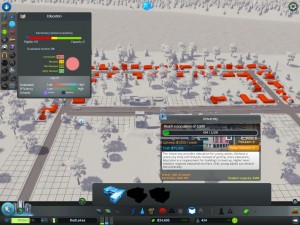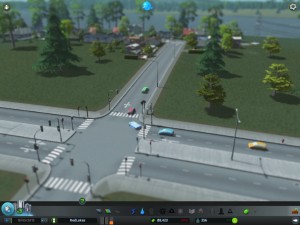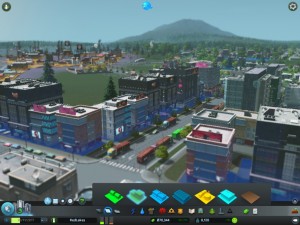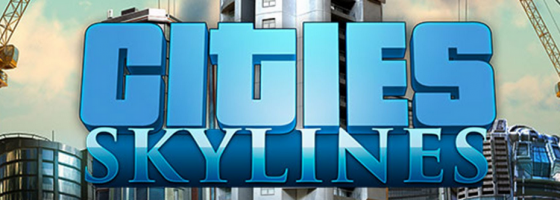Cities: Skylines by Colossal Order has been a breath of fresh air for the city builder genre and has become of the best selling titles from the studio and their publisher Paradox Software. Given the success for the game in a market where the genre has been on the decline, I had a chance to speak to Colossal Order about how Cities: Skylines came about and their thoughts on city building design.
The following interview was done with Karoliina Korppoo, lead designer of Cities: Skylines at Colossal Order
1. To get things started I have a few questions about Colossal Order and general city building design. For people who may not have heard about Colossal before Cities: Skylines, could you tell us a little bit about the history of the studio and what led it into focusing on the city builder genre?
Before Skylines, Colossal Order has made two games, both set in cities. The Cities in Motion series is all about public transportation in cities both modern and historical. We are an independent studio based in Finland and currently have a team of thirteen people. From the very beginning when the studio was founded in 2009, our focus was to work on simulation titles for the PC platform. At the time most companies were interested in mobile games, but we wanted to make big, long projects, so PC was the way to go.
2. City builders can not only be broken down by their design but also by the time period they take place in, such as the Impressions city builders that was based on civilizations like Egypt, Greece etc. What was the attraction to modern architecture and city design that led to the focus for the studio?
Cities are intriguing places. Bustling with life, they can be found from all over the world and are familiar to almost all players. Cities as an environment have a lot going on in a small space, so they are perfect for games.

Modern city builders offer a different kind of challenge compared to historical ones and was a major draw for Colossal Order.
Players can easily imagine what can be done in a city, and the architecture around the world differs so it’s possible to create many interesting types of cities.
3. Building off of the previous question, there are a lot of series that have taken city builders in different directions like Banished, Settlers, Anno etc which sometimes makes it difficult to classify a game as a city builder or as a strategy title. In your opinion, what elements or mechanics are the bread and butter of city builder styled games?
A city builder is all about the game. I’d say that one main thing separating city builders from strategy games is that city builders are about one city at a time. Other genres have cities in them, but focusing on one, large city is typical for a city builder game. Economy simulation, management depth and citizen autonomy are also integral parts.
4. The city builder genre for many fans has been on a big decline over the last few years and especially after the failure of Simcity 5. What is keeping Colossal interested in the genre despite the lack of competition?
Making a city builder game has always been our dream. While many simulation games do okay and gain some attention, city builders are the holy grail of simulation, the types of games that get much attention and appeal to more players than other simulations. We have also been avid city builder fans for a long time and wanted to see the genre brought to life.
5. Moving on to the gameplay, let’s start with the biggest element of Cities: Skylines at the moment — traffic. The traffic model and options available are currently the most in-depth portion of the game experience. Obviously going into the full detail about the work that went into it could take up several pages but could you highlight briefly the work from a design point of view that went into the traffic simulation model?
Roads are made up of connected nodes. Traffic tracks these nodes and their connections to find paths to where they want to travel. There are many types of vehicles using the roads: citizens in their private cars, trucks carrying raw materials to industry buildings, vans taking goods from industry to commercial areas and service vehicles helping out citizens in need. Traffic is vital to any city, it’s the greatest challenge in the game and keeping the traffic flowing is the basis for all city services working well.

The traffic model for Skylines was based on the previous Cities in Motions series with the city building areas expanded on in Skylines
6. And continuing from that question, considering the amount of detail that went into the agent system and design of traffic, was there any research done on actual traffic systems that helped Colossal with developing their simulated model?
We mainly base the system on previous games. We have learned a lot from our previous titles, but still consider modeling traffic to be the biggest challenge in developing a city builder.
7. As we’ve talked about, Cities: Skylines isn’t Colossal’s first city builder as you previously worked on the Cities in Motion series. How does Cities: Skylines differ from your previous games and are there any similarities or elements that have remained consistent in each game?
Cities in Motion games are public transport simulations, and while they are set in cities, the player has only a little effect on the city itself. In Cities in Motion 2 the cities are dynamic, responding to player actions and developing more buildings to areas that are served well by public transport, but other than that the player could not touch the city. CiM 2 was for us a great way to develop the road building tool. Skylines’ road building tool is based on what CiM 2 had, but improved.
Traffic was also a big element in the CiM games, and we have looked long and hard at what we got right and what needed tweaking to get the traffic simulation to work even better for Skylines.
8. Another element I’m curious about is the actual design process for developing a city builder like Cities: Skylines. With so few games in the genre coming out these days, I wanted to ask how does a game like Cities: Skylines grow from an idea to a full game?
We did a lot of research into previous titles. While there had not been successful city builder for some time, the older ones had not lost their charm. Our aim was always to make a game that has the same kind of charm as the old city builders, but with a modern UI and graphics.
9. This next question is one that I like to ask developers who recently started using Steam Workshop integration: What do you think of the service from a game development and user content standpoint? Cities: Skylines isn’t a month old yet and we are already seeing a lot of custom support from fans wanting to improve or contribute to it and are there any plans for enhancements or additions to the workshop support?
Steam is a great way to distribute a game. We can update the game fast and easy for all users and sharing user made content is very easy. Also the Workshop is great for allowing users to rat content, so it’s easy to see which ones are popular and most likely well made. Content that has problems or is of poor quality automatically drops from the top of the list when users rate it. We are very happy with the Steam integration as it is now.
10. One of the challenges of creating a city builder is deciding the level of granularity you want the player to focus on which is also a factor of the game engine. Some city builders just deal with the macro layer of placing buildings and zoning, while others have gone as far as letting you see and affect the growth of your citizens over generations, how buildings operate, etc. How did Colossal settle on the degree of control the player had with the fine details of their city?
We had a set budget, schedule and a team of only eight people when we started on the game. This meant that we had to focus on how the big systems worked and not go into micro management. For me personally, as a designer, this was very rewarding and it seems to make the players happy too.

While building models do repeat at the moment, continued mod and support from Colossal should fix that in the months ahead.
We worked on getting the largest systems working together well, testing them well and making sure the game looked good.
Building a solid base game is important, and means that we can expand it later to go into more detailed management if it seems to please players.
11: Speaking about granularity, are there any plans to offer finer controls for players who really want to dig deep into the mechanics and city planning? Such as setting stop lights,parallel highway tools, designating roads for commercial/public use and so on.
We are currently in a phase where we try to take in all the feedback and plan on expanding the game based of what users want to see. There will most likely be more depth to some parts of the game, but first we are concentrating on making a free update with tunnels.
12. To wrap up this interview, let’s talk a little about the future of Cities: Skylines. Looking at Cities: Skylines and comparing it to other city builders, there are some features that are missing — weather, day/night cycle, scenarios (where the player is tasked with either fixing a failing city or build one in an unusual situation) and the ever popular setting disasters upon your city. I know that your budget was a factor in deciding what to focus on but will we see them at some point down the line?
Everything is possible! I love disasters, and it might be that we see them in the game at some point. We are still looking into the feedback to decide what things would make good expansions.
13. Paradox Software has shown their commitment to post release development and support of their games and Cities: Skylines has already been one of their most successful published titles. Can you talk about what ideas Colossal has for the future of Cities: Skylines? And has there been any talk yet regarding how long Colossal is planning on supporting Cities: Skylines for?
For a very long time! I’m unable to say any specific numbers, but Paradox is known for supporting games for a long time and making lots of added content, and there’s no reason to not do it the same way with Skylines.
Thanks for taking the time to answer these questions and good luck with the future of Cities: Skylines


